Search results for: 'MACHINE+SHO'
-
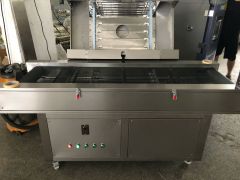 YY-1136 ULTRAVIOLET STERILIZERYY-1136 ULTRAVIOLET STERILIZER MAINTENANCE OF UV STERILIZER: 1 CHECK REGULARLY TO ENSURE THE NORMAL OPERATION OF THE UV LAMP. 2. AFTER 9000 HOURS OR ONE YEAR OF CONTINUOUS USE, THE ULTRAVIOLET LAMP SHOULD BE REPLACED. WHEN REPLACING A NEW LAMP, FIRST UNPLUG THE POWER SOCKET OF THE LAMP AND TAKE OUT THE ULTRAVIOLET LAMP. PAY ATTENTION NOT TO TOUCH THE QUARTZ GLASS OF THE NEW LAMP WITH YOUR FINGERS, BECAUSE THE STAIN WILL AFFECT THE INTENSITY OF THE LIGHT, AND CAREFULLY PUT THE LAMP INTO THE CHAMBER OF THE STERILIZER. Learn More
YY-1136 ULTRAVIOLET STERILIZERYY-1136 ULTRAVIOLET STERILIZER MAINTENANCE OF UV STERILIZER: 1 CHECK REGULARLY TO ENSURE THE NORMAL OPERATION OF THE UV LAMP. 2. AFTER 9000 HOURS OR ONE YEAR OF CONTINUOUS USE, THE ULTRAVIOLET LAMP SHOULD BE REPLACED. WHEN REPLACING A NEW LAMP, FIRST UNPLUG THE POWER SOCKET OF THE LAMP AND TAKE OUT THE ULTRAVIOLET LAMP. PAY ATTENTION NOT TO TOUCH THE QUARTZ GLASS OF THE NEW LAMP WITH YOUR FINGERS, BECAUSE THE STAIN WILL AFFECT THE INTENSITY OF THE LIGHT, AND CAREFULLY PUT THE LAMP INTO THE CHAMBER OF THE STERILIZER. Learn More -
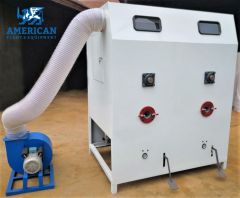 AA-1166 PILLOW FILLING MACHINE FOR FEATHERS AND DOWN, 2 NOZZLES -FOR FIBER, POLYESTER FIBER, PP COTTON, WOOLAA-1166 PILLOW FILLING MACHINE FOR FEATHERS AND DOWN, 2 NOZZLES -FOR FIBER, POLYESTER FIBER, PP COTTON, WOOL VOLTAGE: 220 VOLTS / 60 Hz AIR PRESSURE: 0.7 TO 0.8 MPa PACKED DIMENSIONS: 1500 x 1180 x 1840mm NET WEIGHT: 360 KGS GROSS WEIGHT: 429 KGS FILLING: FIBER, POLYESTER FIBER, PP COTTON, WOOL Learn More
AA-1166 PILLOW FILLING MACHINE FOR FEATHERS AND DOWN, 2 NOZZLES -FOR FIBER, POLYESTER FIBER, PP COTTON, WOOLAA-1166 PILLOW FILLING MACHINE FOR FEATHERS AND DOWN, 2 NOZZLES -FOR FIBER, POLYESTER FIBER, PP COTTON, WOOL VOLTAGE: 220 VOLTS / 60 Hz AIR PRESSURE: 0.7 TO 0.8 MPa PACKED DIMENSIONS: 1500 x 1180 x 1840mm NET WEIGHT: 360 KGS GROSS WEIGHT: 429 KGS FILLING: FIBER, POLYESTER FIBER, PP COTTON, WOOL Learn More -
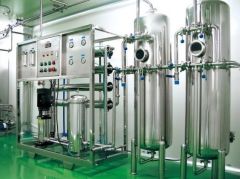 A-2591 100L/200L HOMOGENIZING AND MIXING TANK (NEW)A-2591 100L/200L HOMOGENIZING AND MIXING TANK (NEW) 100L HOMOGENIZING AND MIXING TANK (BOTTOM HOMOGENIZER & BUTTON CONTROL) • DESIGN CAPACITY: 125 L, WORKING CAPACITY: 100 L • ELECTRIC HEATING • MIXING: FIXED STIRRER + WALL - SCRATCHING AGITATOR + PTFE BLADES POWER: 2.2 KW, SIEMENS JV BRAND • FREQUENCY SPEED ADJUSTABLE, 0 TO 63 RPM, DELTA ORIGINAL BRAND • HOMOGENIZING: BOTTOM CENTER INSERT HIGH SHEAR HOMOGENIZER POWER: 4 KW FREQUENCY SPEED ADJUSTABLE: 0 TO 3000 RPM, DELTA ORIGINAL BRAND • ROTOR AND STATER INCORPORATES WIRE - CUTTING FINISH MACHINING, POLISHING TREATMENT BEFORE ASSEMBLY, AXIS INCORPORATE DYNAMIC BALANCE PROCESSING • BUTTON CONTROL, WATER - PROOF ELECTRICITY CONTROL BOX • ALL MOTOR: EX – PROOF QUANTITY: 1 SET 200L HOMOGENIZING AND MIXING TANK (BOTTOM HOMOGENIZER & BUTTON CONTROL) • DESIGN CAPACITY: 250 L WORKING CAPACITY: 200 L • ELECTRIC HEATING • MIXING: FIXED STIRRER + WALL - SCRATCHING AGITATOR + PTFE BLADES • POWER: 2.2 KW, SIEMENS JV BRAND • FREQUENCY SPEED ADJUSTABLE, 0 TO 63 RPM, DELTA ORIGINAL BRAND • HOMOGENIZING: BOTTOM CENTER INSERT HIGH SHEAR HOMOGENIZER • POWER: 4 KW • FREQUENCY SPEED ADJUSTABLE: 0 TO 3000 RPM, DELTA ORIGINAL BRAND • ROTOR AND STATER INCORPORATES WIRE - CUTTING FINISH MACHINING, POLISHING TREATMENT BEFORE ASSEMBLY, AXIS INCORPORATE DYNAMIC BALANCE PROCESSING • BUTTON CONTROL, WATER - PROOF ELECTRICITY CONTROL BOX • ALL MOTOR:EX-PROOF QUANTITY: 1 SET Learn More
A-2591 100L/200L HOMOGENIZING AND MIXING TANK (NEW)A-2591 100L/200L HOMOGENIZING AND MIXING TANK (NEW) 100L HOMOGENIZING AND MIXING TANK (BOTTOM HOMOGENIZER & BUTTON CONTROL) • DESIGN CAPACITY: 125 L, WORKING CAPACITY: 100 L • ELECTRIC HEATING • MIXING: FIXED STIRRER + WALL - SCRATCHING AGITATOR + PTFE BLADES POWER: 2.2 KW, SIEMENS JV BRAND • FREQUENCY SPEED ADJUSTABLE, 0 TO 63 RPM, DELTA ORIGINAL BRAND • HOMOGENIZING: BOTTOM CENTER INSERT HIGH SHEAR HOMOGENIZER POWER: 4 KW FREQUENCY SPEED ADJUSTABLE: 0 TO 3000 RPM, DELTA ORIGINAL BRAND • ROTOR AND STATER INCORPORATES WIRE - CUTTING FINISH MACHINING, POLISHING TREATMENT BEFORE ASSEMBLY, AXIS INCORPORATE DYNAMIC BALANCE PROCESSING • BUTTON CONTROL, WATER - PROOF ELECTRICITY CONTROL BOX • ALL MOTOR: EX – PROOF QUANTITY: 1 SET 200L HOMOGENIZING AND MIXING TANK (BOTTOM HOMOGENIZER & BUTTON CONTROL) • DESIGN CAPACITY: 250 L WORKING CAPACITY: 200 L • ELECTRIC HEATING • MIXING: FIXED STIRRER + WALL - SCRATCHING AGITATOR + PTFE BLADES • POWER: 2.2 KW, SIEMENS JV BRAND • FREQUENCY SPEED ADJUSTABLE, 0 TO 63 RPM, DELTA ORIGINAL BRAND • HOMOGENIZING: BOTTOM CENTER INSERT HIGH SHEAR HOMOGENIZER • POWER: 4 KW • FREQUENCY SPEED ADJUSTABLE: 0 TO 3000 RPM, DELTA ORIGINAL BRAND • ROTOR AND STATER INCORPORATES WIRE - CUTTING FINISH MACHINING, POLISHING TREATMENT BEFORE ASSEMBLY, AXIS INCORPORATE DYNAMIC BALANCE PROCESSING • BUTTON CONTROL, WATER - PROOF ELECTRICITY CONTROL BOX • ALL MOTOR:EX-PROOF QUANTITY: 1 SET Learn More -
 AUTEFA, DILO, TEMAFA NONWOVEN LINE, YEAR 1970REFERENCE NUMBER: T-6853 AUTEFA, DILO, TEMAFA NONWOVEN LINE, YEAR 1970 BRAND: AUTEFA, DILO, TEMAFA SHORT DESCRIPTION: NONWOVEN LINE YEAR 1970 SUITABLE FOR PRODUCTION: 1500 GRS/SQUARE METER COMPOSED OF: 1 BESSI CARD, WORKING WIDTH 2500mm -TEMAFA FEEDER -BREAST ROLLER DIAMETER 1500mm, 7 COUPLE OF WORKERS, DIAMETER 220/74 -DOFFER DIAMETER 1285mm -DRUM DIAMETER 1500mm, 6 COUPLE OF WORKERS -DOFFER DIAMETER 1500mm -FLY COMB 1 AUTEFA CROSS LAPPER MODEL MAK IN WORKING WIDTH 2500mm, DELIVERY 3000mm 1 DILO NFZ30DO PRE-NEEDLE/NEEDLE MACHINE, YEAR 1967, 5160 NEEDLES /METER 2 MACHI LONGITUDINAL CUTTERS 1 SPINBAU TRANSVERSAL CUTTER 1 WINDER ON WEIGHS (LOADING CELLS METTLER) QUANTITY: 1 Learn More
AUTEFA, DILO, TEMAFA NONWOVEN LINE, YEAR 1970REFERENCE NUMBER: T-6853 AUTEFA, DILO, TEMAFA NONWOVEN LINE, YEAR 1970 BRAND: AUTEFA, DILO, TEMAFA SHORT DESCRIPTION: NONWOVEN LINE YEAR 1970 SUITABLE FOR PRODUCTION: 1500 GRS/SQUARE METER COMPOSED OF: 1 BESSI CARD, WORKING WIDTH 2500mm -TEMAFA FEEDER -BREAST ROLLER DIAMETER 1500mm, 7 COUPLE OF WORKERS, DIAMETER 220/74 -DOFFER DIAMETER 1285mm -DRUM DIAMETER 1500mm, 6 COUPLE OF WORKERS -DOFFER DIAMETER 1500mm -FLY COMB 1 AUTEFA CROSS LAPPER MODEL MAK IN WORKING WIDTH 2500mm, DELIVERY 3000mm 1 DILO NFZ30DO PRE-NEEDLE/NEEDLE MACHINE, YEAR 1967, 5160 NEEDLES /METER 2 MACHI LONGITUDINAL CUTTERS 1 SPINBAU TRANSVERSAL CUTTER 1 WINDER ON WEIGHS (LOADING CELLS METTLER) QUANTITY: 1 Learn More -
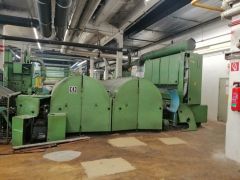 SPINNBAU, TRUTZSCHLER FBK, 2500 FEEDER WITH CARD, YEAR 1985 AND 1986REFERENCE NUMBER: T-6849 SPINNBAU, TRUTZSCHLER FBK, 2500 FEEDER WITH CARD, YEAR 1985 AND 1986 BRAND: SPINNBAU, TRUTZSCHLER MODEL: FBK, 2500 SHORT DESCRIPTION: FEEDER WITH CARD YEAR: 1985 AND 1986 ITEM 001 VOLUMETRIC HOPPER FEEDER TRUTZSCHLER FBK WORKING WIDTH 2500mm YEAR: 1986 QUANTITY: 1 ITEM 002 SINGLE-DOFFER CARDING MACHINE SPINNBAU 2500 WORKING WIDTH 2500mm YEAR: 1985 QUANTITY: 1 Learn More
SPINNBAU, TRUTZSCHLER FBK, 2500 FEEDER WITH CARD, YEAR 1985 AND 1986REFERENCE NUMBER: T-6849 SPINNBAU, TRUTZSCHLER FBK, 2500 FEEDER WITH CARD, YEAR 1985 AND 1986 BRAND: SPINNBAU, TRUTZSCHLER MODEL: FBK, 2500 SHORT DESCRIPTION: FEEDER WITH CARD YEAR: 1985 AND 1986 ITEM 001 VOLUMETRIC HOPPER FEEDER TRUTZSCHLER FBK WORKING WIDTH 2500mm YEAR: 1986 QUANTITY: 1 ITEM 002 SINGLE-DOFFER CARDING MACHINE SPINNBAU 2500 WORKING WIDTH 2500mm YEAR: 1985 QUANTITY: 1 Learn More -
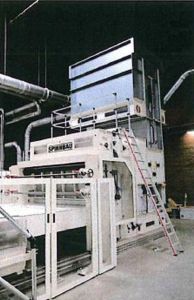 SPINNBAU CARDING LINE, YEAR 2013REFERENCE NUMBER: T-6848 SPINNBAU CARDING LINE, YEAR 2013 BRAND: SPINNBAU SHORT DESCRIPTION: CARDING LINE YEAR: 2013 INSTALLED 2014 LIKE NEW, LITTLE RUN TIME 4 HOPPER TEMAFA BLEND LINE, 1600mm WIDE, 1 WITH CONDENSER FED FROM TRIM MACHINE CARDING WILLOW – 800mm WIDE FEED BELT AND 1200mm WIDE – TEMAFA TEMAFA MIXMASTER BLENDING BIN – 3000mm WIDE X 8000mm LONG X 4600mm HIGH (FILL HEIGHT 3000mm). 72 CUBIC METER CAPACITY. TEMAFA FINE OPENER – 2000mm WIDE WITH PINS 3000mm SPINNBAU CARD FEEDING UNIT – FEED TRUNK, VIBRATING CHUTE, WEIGHT BELT 708mm BREAST SECTION WITH 3 WORKERS AND STRIPPERS, 1500mm MAIN WITH 5 W/S AND (2) 708mm DOFFERS. 1 FOUNDATIONS AND PLATFORMS. DILO PROFILINE – BATT WEIGHT CONTROL SYSTEM MAHLO WEIGHT MEASURING UNIT – QUALISCAN CMS-12 DILO LAYER CROSSLAPPER – TYPE DLS 30/60 – 3000mm INFEED AND UP TO 6000mm LAYDOWN. MAX WEB HEIGHT 650mm. MAXIMUM SPEED 125M/MIN. SPINNBAU LAP DRAFTER TYPE VST 19 – MAX 6000mm WORKING WIDTH. 9 ROLLER PAIRS. LIFTING DEVICE TO ALLOW FOR 600mm CLEARANCE. 159mm ROLLER DIAMETER. INFEED HEIGHT 650 mm BRUCKNER THERMOBONDING OVEN – 5000mm OVEN WITH 3 HEATING AND 2 COOLING ZONE. MAGNETIC BELT. 3 NATURAL GAS MAXON BURNER. SLITTING – 9 POSITION BRUCKNER CRUSH CUTTER SLITTING HEADS. PNEUMATIC LIFTING. 450mm KNIFE DIAMETER CROSS CUTTER – ROTARY CUTTER STYLE WITH CLAMPING. CAPABLE OF 3 CUTS/MINUTES FOR MATERIALS UP TO 200mm THICK. WINDING – ASCENDING BATCH STYLE WINDER. MAX ROLL DIAMETER OF 1200mm. 3000mm DRIVEN FEED CONVEYOR. MANDREL GUIDANCE SYSTEM, MANUALLY ADJUSTABLE BRAKE SYSTEM FOR CONTROLLING TENSILE FORCE AND COMPACTION. TEMAFA FILTER HOUSE – TFS 50. MAX FLOW 50,000 CUBIC METER/H ELECTRICL INFO – 3 X 480V/60Hz. CONTROLS 110V AC/24 DC. SIEMENS PLC QUANTITY: 1 Learn More
SPINNBAU CARDING LINE, YEAR 2013REFERENCE NUMBER: T-6848 SPINNBAU CARDING LINE, YEAR 2013 BRAND: SPINNBAU SHORT DESCRIPTION: CARDING LINE YEAR: 2013 INSTALLED 2014 LIKE NEW, LITTLE RUN TIME 4 HOPPER TEMAFA BLEND LINE, 1600mm WIDE, 1 WITH CONDENSER FED FROM TRIM MACHINE CARDING WILLOW – 800mm WIDE FEED BELT AND 1200mm WIDE – TEMAFA TEMAFA MIXMASTER BLENDING BIN – 3000mm WIDE X 8000mm LONG X 4600mm HIGH (FILL HEIGHT 3000mm). 72 CUBIC METER CAPACITY. TEMAFA FINE OPENER – 2000mm WIDE WITH PINS 3000mm SPINNBAU CARD FEEDING UNIT – FEED TRUNK, VIBRATING CHUTE, WEIGHT BELT 708mm BREAST SECTION WITH 3 WORKERS AND STRIPPERS, 1500mm MAIN WITH 5 W/S AND (2) 708mm DOFFERS. 1 FOUNDATIONS AND PLATFORMS. DILO PROFILINE – BATT WEIGHT CONTROL SYSTEM MAHLO WEIGHT MEASURING UNIT – QUALISCAN CMS-12 DILO LAYER CROSSLAPPER – TYPE DLS 30/60 – 3000mm INFEED AND UP TO 6000mm LAYDOWN. MAX WEB HEIGHT 650mm. MAXIMUM SPEED 125M/MIN. SPINNBAU LAP DRAFTER TYPE VST 19 – MAX 6000mm WORKING WIDTH. 9 ROLLER PAIRS. LIFTING DEVICE TO ALLOW FOR 600mm CLEARANCE. 159mm ROLLER DIAMETER. INFEED HEIGHT 650 mm BRUCKNER THERMOBONDING OVEN – 5000mm OVEN WITH 3 HEATING AND 2 COOLING ZONE. MAGNETIC BELT. 3 NATURAL GAS MAXON BURNER. SLITTING – 9 POSITION BRUCKNER CRUSH CUTTER SLITTING HEADS. PNEUMATIC LIFTING. 450mm KNIFE DIAMETER CROSS CUTTER – ROTARY CUTTER STYLE WITH CLAMPING. CAPABLE OF 3 CUTS/MINUTES FOR MATERIALS UP TO 200mm THICK. WINDING – ASCENDING BATCH STYLE WINDER. MAX ROLL DIAMETER OF 1200mm. 3000mm DRIVEN FEED CONVEYOR. MANDREL GUIDANCE SYSTEM, MANUALLY ADJUSTABLE BRAKE SYSTEM FOR CONTROLLING TENSILE FORCE AND COMPACTION. TEMAFA FILTER HOUSE – TFS 50. MAX FLOW 50,000 CUBIC METER/H ELECTRICL INFO – 3 X 480V/60Hz. CONTROLS 110V AC/24 DC. SIEMENS PLC QUANTITY: 1 Learn More -
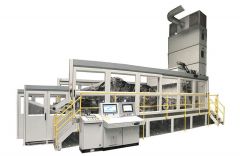 SPINNBAU DOUBLE DOFFER NONWOVEN CARDREFERENCE NUMBER: T-6847 SPINNBAU DOUBLE DOFFER NONWOVEN CARD BRAND: SPINNBAU SHORT DESCRIPTION: DOUBLE DOFFER NONWOVEN CARD NEW HIGH CAPACITY HOPPER FEEDER WITH CHUTE DELIVERY ELECTRONIC WEIGH SYSTEM “TS MICROFEED” NEW AC INVERTER DRIVE SYSTEM WITH TOUCH SCREEN CONTROL NEW AC GEARED MOTOR UNITS NEW DRIVE BELTS AS REQUIRED NEW SAFETY CIRCUIT, E-STOPS AND GUARD INTERLOCKS INCLUDING MACHINE REFURBISHMENT AND RE-PAINT TO RAL 7035 (LIGHT GREY) THE 2500mm SPINNBAU CARD CAN BE SPECIFIED FOR YOUR PRODUCTION REQUIREMENTS TOGETHER WITH A NEW CROSSLAPPER, OVENS AND NEEDLE LOOMS. RE-CONDITIONED QUANTITY: 1 Learn More
SPINNBAU DOUBLE DOFFER NONWOVEN CARDREFERENCE NUMBER: T-6847 SPINNBAU DOUBLE DOFFER NONWOVEN CARD BRAND: SPINNBAU SHORT DESCRIPTION: DOUBLE DOFFER NONWOVEN CARD NEW HIGH CAPACITY HOPPER FEEDER WITH CHUTE DELIVERY ELECTRONIC WEIGH SYSTEM “TS MICROFEED” NEW AC INVERTER DRIVE SYSTEM WITH TOUCH SCREEN CONTROL NEW AC GEARED MOTOR UNITS NEW DRIVE BELTS AS REQUIRED NEW SAFETY CIRCUIT, E-STOPS AND GUARD INTERLOCKS INCLUDING MACHINE REFURBISHMENT AND RE-PAINT TO RAL 7035 (LIGHT GREY) THE 2500mm SPINNBAU CARD CAN BE SPECIFIED FOR YOUR PRODUCTION REQUIREMENTS TOGETHER WITH A NEW CROSSLAPPER, OVENS AND NEEDLE LOOMS. RE-CONDITIONED QUANTITY: 1 Learn More -
 T-6550 MEDICAL PROTECTIVE CLOTHING BLOOD SYNTHETIC PENETRABILITY TESTER
T-6550 MEDICAL PROTECTIVE CLOTHING BLOOD SYNTHETIC PENETRABILITY TESTERREFERENCE NUMBER: T-6550
MEDICAL PROTECTIVE CLOTHING BLOOD SYNTHETIC PENETRABILITY TESTER
TECHNICAL SPECIFICATIONS AND CONFIGURATION:
1. THE INSTRUMENT ADOPTS AN AIR SOURCE THAT CAN PROVIDE (0.5 ~ 30±0.1) KPA PRESSURE TO CONTINUOUSLY PRESSURIZED THE SAMPLE, WHICH IS NOT RESTRICTED BY THE SPACE OF THE TEST SITE;
2. THE AIR PRESSURE RANGE CAN BE ADJUSTED FREELY, AND THE ADJUSTMENT RANGE (0.5 ~ 30) KPA;
3. COLOR TOUCH SCREEN DISPLAY AND OPERATION;
4. THE SAMPLE CLAMPING PAD IS PROCESSED WITH IMPORTED SPECIAL ALUMINUM PROFILES, WHICH IS LIGHT IN MATERIAL, CLEAN IN SURFACE AND NEVER RUSTS.
5. THE INSTRUMENT ADOPTS IMPORTED SPECIAL ALUMINUM WIRE DRAWING PANEL, EQUIPPED WITH METAL KEYS, SENSITIVE OPERATION, NOT EASY TO DAMAGE;
6. CLAMPING DEVICE FOR INSTRUMENT SAMPLES, EQUIPPED WITH LOCKING PROTECTION, TO PREVENT THE SYNTHETIC BLOOD FROM SPLASHING AROUND;
7. CLAMPING FORCE IS ACCURATE AND RELIABLE;
8. THE TEST TANK IS EQUIPPED WITH A SPECIAL PLACEMENT DEVICE, WHICH IS CONVENIENT FOR CUSTOMERS TO OPERATE;
9. THE TEST TANK IS PROCESSED WITH SPECIAL 316 STAINLESS STEEL, AND THE TOP IS EQUIPPED WITH A SPECIAL COVER FOR HIGH TRANSPARENT PROTECTION;
10. THE WASHER BELOW THE SAMPLE IS MADE OF HIGH-QUALITY PTFE MATERIAL AFTER SPECIAL PROCESSING;
11. SQUARE METAL BLOCK NET: OPEN SPACE ≥50°%; BENDING ≤5mm AT 30KPA;
12. INSTRUMENT TIME CONTROL ACCURACY ≤01 SECONDS;
13. THE SHELL OF THE INSTRUMENT IS MADE OF HIGH-QUALITY METAL BAKING PAINT, WHICH IS BEAUTIFUL AND GENEROUS.
14. EQUIPPED WITH PRINTER INTERFACE, CONNECTED TO THE PRINTER CAN DIRECTLY PRINT DATA REPORTS.
TECHNICAL PARAMETERS:
1. SAMPLE SIZE: 75mm X 75mm
2. TEST AREA: 28.26 SQUARE CENTIMETERS
3. AIR PRESSURE ADJUSTMENT RANGE (0.5 ~ 30) KPA
4. EXTERNAL SIZE: 500mm X 500mm X 500mm (L X W X H)
5. WEIGHT OF THE INSTRUMENT: 40 KG
6. POWER SUPPLY: AC220V, 50HZ,SCOPE OF SUPPLY: 1. ONE MAIN MACHINE; 2. TWO PTFE GASKETS; 3. TWO ORDINARY WASHERS; 4. ONE METAL BLOCKING NET; 5. A SET OF SPECIAL LOCKING TOOLS; 6. ONE HIGH-QUALITY SILENT AIR PUMP, [NOTE: SAFETY PRODUCTION LICENSE IS NOT INCLUDED]. 7. EQUIPPED WITH PRINTER INTERFACE; 8. ONE SAMPLE TEMPLATE; 9. ONE PRODUCT CERTIFICATE; 10. ONE COPY OF PRODUCT OPERATION MANUAL.
OPERATION INSTRUCTION:
INSERT THE AIR PUMP OUTPUT PIPE INTO THE OIL AND WATER SEPARATOR OF THE INSTRUMENT AS REQUIRED (PRESSURE 0.1-0.3MPA).
AFTER SWITCHING ON THE POWER, THE STARTUP INTERFACE (NAME OF THE DEVICE) IS DISPLAYED.
PRESS THE "ENTER" BUTTON TO ENTER THE TEST INTERFACE, AS SHOWN IN THE FOLLOWING FIGURE:
CLICK "SETTING” BUTTON, GET INTO PARAMETER SETTING SCREEN, AS BELOW THIS SCREEN CAN SET THE SYSTEM TIME, DATE AND TESTING TIME, AFTER SETTING, CLICK "SAVE” BUTTON TO KEEP THE SETTING DATA. (NOTE: IT REQUIRES 5 MINUTES IN THE STANDARD)
QUANTITY: 1
Learn More -
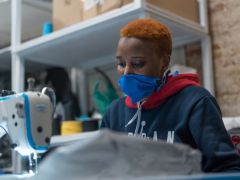 D-2388 What’s the Best Material for a Mask?
D-2388 What’s the Best Material for a Mask?Federal health officials have now recommended that we cover our faces with fabric during the coronavirus pandemic. But what material offers the most protection?
The Centers for Disease Control and Prevention has posted a no-sew mask pattern using a bandanna and a coffee filter as well as a video on making masks using rubber bands and folded fabrics found at home.
While a simple face covering can reduce the spread of coronavirus by blocking outgoing germs from coughs or sneezes of an infected person, experts say there is more variation in how much homemade masks might protect the wearer from incoming germs, depending on the fit and quality of the material used.
Scientists around the country have taken it upon themselves to identify everyday materials that do a better job of filtering microscopic particles. In recent tests, HEPA furnace filters scored well, as did vacuum cleaner bags, layers of 600-count pillowcases and fabric similar to flannel pajamas. Stacked coffee filters had medium scores. Scarves and bandanna material had the lowest scores, but still captured a small percentage of particles.
If you don’t have any of the materials that were tested, a simple light test can help you decide whether a fabric is a good candidate for a mask.
“Hold it up to a bright light,” said Dr. Scott Segal, chairman of anesthesiology at Wake Forest Baptist Health who recently studied homemade masks. “If light passes really easily through the fibers and you can almost see the fibers, it’s not a good fabric. If it’s a denser weave of thicker material and light doesn’t pass through it as much, that’s the material you want to use.”
Researchers say it’s important to remember that lab studies are conducted under perfect conditions with no leaks or gaps in the mask, but the test methods give us a way to compare materials. And while the degree of filtration for some homemade masks seems low, most of us — who are staying home and practicing social distancing in public — don’t need the high level of protection required for medical workers. More important, any face covering is better than none, especially if worn by a person who has the virus but doesn’t know it.
The biggest challenge of choosing a homemade mask material is to find a fabric that is dense enough to capture viral particles, but breathable enough that we can actually wear it. Some items being touted online promise high filtration scores, but the material would be unwearable.
Dressing Up for Work … at Home
Yang Wang, an assistant professor of environmental engineering at Missouri University of Science and Technology, worked with his graduate students to study various combinations of layered materials — including both air filters and fabric. “You need something that is efficient for removing particles, but you also need to breathe,” said Dr. Wang, who last fall won an international award for aerosol research.To test everyday materials, scientists are using methods similar to those used to test medical masks, which everybody agrees should be saved for medical workers who are exposed to high doses of virus from seeing infected patients. The best medical mask — called the N95 respirator — filters out at least 95 percent of particles as small as 0.3 microns. By comparison, a typical surgical mask — made using a rectangular piece of pleated fabric with elastic ear loops — has a filtration efficiency ranging from 60 to 80 percent.
Dr. Wang’s group tested two types of air filters. An allergy-reduction HVAC filter worked the best, capturing 89 percent of particles with one layer and 94 percent with two layers. A furnace filter captured 75 percent with two layers, but required six layers to achieve 95 percent. To find a filter similar to those tested, look for a minimum efficiency reporting value (MERV) rating of 12 or higher or a microparticle performance rating of 1900 or higher.
The problem with air filters is that they potentially could shed small fibers that would be risky to inhale. So if you want to use a filter, you need to sandwich the filter between two layers of cotton fabric. Dr. Wang said one of his grad students made his own mask by following the instructions in the C.D.C. video, but adding several layers of filter material inside a bandanna.
Dr. Wang’s group also found that when certain common fabrics were used, two layers offered far less protection than four layers. A 600 thread count pillow case captured just 22 percent of particles when doubled, but four layers captured nearly 60 percent. A thick woolen yarn scarf filtered 21 percent of particles in two layers, and 48.8 percent in four layers. A 100 percent cotton bandanna did the worst, capturing only 18.2 percent when doubled, and just 19.5 percent in four layers.
The group also tested Brew Rite and Natural Brew basket-style coffee filters, which, when stacked in three layers, showed 40 to 50 percent filtration efficiency — but they were less breathable than other options.
If you are lucky enough to know a quilter, ask them to make you a mask. Tests performed at the Wake Forest Institute for Regenerative Medicine in Winston-Salem, N.C., showed good results for homemade masks using quilting fabric. Dr. Segal, of Wake Forest Baptist Health, who led the study, noted that quilters tend to use high-quality, high-thread count cotton. The best homemade masks in his study were as good as surgical masks or slightly better, testing in the range of 70 to 79 percent filtration. Homemade masks that used flimsier fabric tested as low as 1 percent filtration, Dr. Segal said.
The best-performing designs were a mask constructed of two layers of high-quality, heavyweight “quilter’s cotton,” a two-layer mask made with thick batik fabric, and a double-layer mask with an inner layer of flannel and outer layer of cotton.
Bonnie Browning, executive show director for the American Quilter’s Society, said that quilters prefer tightly woven cottons and batik fabrics that stand up over time. Ms. Browning said most sewing machines can handle only two layers of fabric when making a pleated mask, but someone who wanted four layers of protection could wear two masks at a time.
Ms. Browning said she recently reached out to quilters on Facebook and heard from 71 people who have made a combined total of nearly 15,000 masks. “We quilters are very much in the thick of what’s going on with this,” said Ms. Browning, who lives in Paducah, Ky. “One thing most of us have is a stash of fabric.”
People who don’t sew could try a folded origami mask, created by Jiangmei Wu, assistant professor of interior design at Indiana University. Ms. Wu, who is known for her breathtaking folded artwork, said she began designing a folded mask out of a medical and building material called Tyvek, as well as vacuum bags, after her brother in Hong Kong, where mask wearing is common, suggested it. (DuPont, the maker of Tyvek, said in a statement that Tyvek is intended for medical apparel, not masks.) The folded mask pattern is free online, as is a video demonstrating the folding process. In tests at Missouri University and University of Virginia, scientists found that vacuum bags removed between 60 percent and 87 percent of particles. But some brands of vacuum bags may contain fiberglass or are harder to breathe through than other materials, and shouldn’t be used. Ms. Wu used a bag by EnviroCare Technologies, which has said it does not use fiberglass in its paper and synthetic cloth bags.
“I wanted to create an alternative for people who don’t sew,” said Ms. Wu, who said she is talking to various groups to find other materials that will be effective in a folded mask. “Given the shortage of all kinds of materials, even vacuum bags might run out.”
The scientists who conducted the tests used a standard of 0.3 microns because that is the measure used by the National Institute for Occupational Safety and Health for medical masks.
Linsey Marr, a Virginia Tech aerosol scientist and an expert in the transmission of viruses, said the certification method for respirators and HEPA filters focuses on 0.3 microns because particles around that size are the hardest to catch. While it seems counterintuitive, particles smaller than 0.1 microns are actually easier to catch because they have a lot of random motion that makes them bump into the filter fibers, she said.
“Even though coronavirus is around 0.1 microns, it floats around in a wide range of sizes, from around 0.2 to several hundred microns, because people shed the virus in respiratory fluid droplets that also contain lots of salts and proteins and other things,” said Dr. Marr. “Even if the water in the droplets fully evaporates, there’s still a lot of salt and proteins and other gunk that stays behind as solid or gel-like material. I think 0.3 microns is still useful for guidance because the minimum filtration efficiency will be somewhere around this size, and it’s what NIOSH uses.”
Learn More -
 R-8860 MERTZ CC4II, CYLINDER: 3 3/4”, YEAR 2015
R-8860 MERTZ CC4II, CYLINDER: 3 3/4”, YEAR 2015REFERENCE NUMBER: R-8860
Learn More
MERTZ CC4II
YEAR: 2015
QUANTITY: 7
